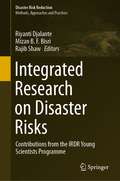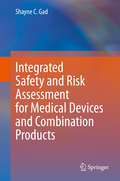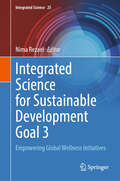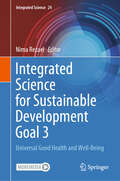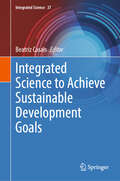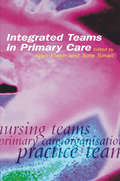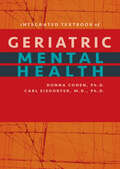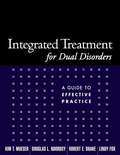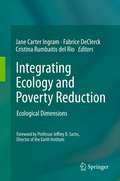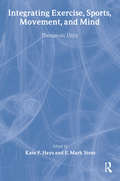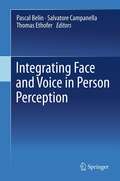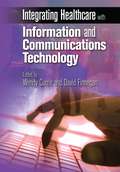- Table View
- List View
Integrated Primary and Behavioral Care
by William O'Donohue Alexandros MaragakisThis timely analysis spotlights the concepts and possibilities of the Patient-Centered Medical Home for bringing mental health and other specialties into primary care. Overview chapters present the Patient-Centered Medical Home model, emphasizing how such systems are organized to solve widespread problems with accessibility, affordability, efficiency, and safety. Practitioner roles, boundaries, and opportunities plus applications are clarified, as well as staffing, financial, and technological challenges. And the section on applications describe care models for special populations, such as comprehensive services to the seriously mentally ill and behavioral services to patients with chronic health conditions. Included in the coverage: Integrated care and specialty behavioral health care in the patient-centered medical home. Training the behavioral health workforce for the patient-centered medical home. The importance of stepped care protocols for the redesign of behavioral health care in patient-centered medical homes. Depression management in the medical home. Treating obesity in a primary care setting. Integrating behavioral health in the pediatric medical home. For health and clinical psychologists, primary care and family physicians, and public health professionals, Integrated Primary and Behavioral Care represents the potential for an exciting new frontier in primary care reform.
Integrated Procedures in Facial Cosmetic Surgery
by Shahrokh C. Bagheri Seied Omid Keyhan Tirbod Fattahi Behnam Bohluli Mohammad Hosein Amirzade-IranaqPhysical attractiveness of the face has a significant impact on the social life and daily interaction of individuals as well as one’s general perception of life. Proper surgical planning for aesthetic facial surgery requires a meticulous analysis of the patient’s current and desired facial features from the perspective of both soft and hard tissues. Significantly greater changes to facial aesthetics can be made via the alteration of the main bony structures of the face than by alteration of soft tissue and skin alone. Various surgical and clinical techniques are available for the augmentation, reduction or refinement of the most prominent aspects of facial aesthetics, such as alterations to the cheek, chin, nose, para-nasal area, as well as the angle of the jaw. These techniques can be categorized as office-based or non-invasive techniques (filler injections, facial liposculpture or liposuction to modify the soft tissue of the face) and invasive surgical interventions such as facial prosthesis and maxillofacial osteotomies. In order to achieve the optimum aesthetic results for patients who undergo bi-maxillary or mono-maxillary orthognathic surgery, it is of paramount importance to utilize a hard and soft-tissue integrated approach. These integrated approaches have utilized the latest techniques in 3-dimentional printing, computer-assisted surgery, tissue engineering and stem-cell therapy in order to achieve positive and lasting outcomes. Integrated Procedures in Facial Cosmetic Surgery includes chapters that focus on facial analysis and clinical evaluation and best practices in surgical techniques such as: principles of bone contouring; genioplasty; mentoplasty; malarplasty; rhinoplasty; orthognatic surgery and intra-oral plastic surgery; lifting procedures like blepharoplasty; surgical approaches to cleft lip and palate surgery; as well as the principles of facial photography. Written by a team of renowned international experts, this textbook features over 900 original photographs, fully illustrating each procedure in a stepwise manner. Integrated Procedures in Facial Cosmetic Surgery is an essential companion for oral and maxillofacial surgeons, plastic surgeons and otolaryngologists, as well as for cosmetic surgeons and clinical residents dealing with face rejuvenation. Its contents will also be of interest to dentists, prosthodontists, periodontists, radiologists, general surgeons, and dermatologists.
Integrated Research on Disaster Risks: Contributions from the IRDR Young Scientists Programme (Disaster Risk Reduction)
by Rajib Shaw Riyanti Djalante Mizan B. F. BisriThis book is a collection of works written by young scientists involved in the Integrated Disaster Risk Research (IRDR). Integrated Research on Disaster Risk (IRDR) is a decade-long research programme co-sponsored by the International Science Council (merged by International Council for Science (ICSU), the International Social Science Council (ISSC), and the United Nations Office for Disaster Risk Reduction (UNDRR). It is a global, multi-disciplinary approach to dealing with the challenges brought by natural disasters, mitigating their impacts, and improving related policy-making mechanisms. The book examines multidisciplinary research and actions related to disaster risk reduction internationally. The Integrated Research on Disaster Risk (IRDR) Young Scientists programme is: • A sub-programme within IRDR which promotes capacity building of young professionals and encourages them to undertake innovative and need-based research which makes science–policy and science–practice linkages stronger. • IRDR Young Scientists Programme was started in late 2016. Currently, it is a community of 115 young researchers from over 40 countries after 3 batches of application. • IRDR network and partners provide academic advice and training courses, workshops, and programmes for IRDR young scientists. • IRDR young scientists contribute to innovative research in the field of disaster risk reduction and participate in conferences and/or social media as the ambassador of IRDR. The book is of interest to researchers and scholars in the field of governance of sustainability and environmental governance. Postgraduate students will benefit this book within courses on environmental governance, on climate change governance, and on transformation and social change processes. Societal actors in climate change adaptation and other environmental governance fields on local, national, and international levels can benefit from the focus on societally relevant findings in the past 10 years of research on adaptiveness.
Integrated Risk of Pandemic: Covid-19 Impacts, Resilience and Recommendations (Disaster Resilience and Green Growth)
by Anil Kumar Gupta Manish Kumar GoyalIn light of the novel corona virus outbreak in December 2019 and its subsequent impact on entire world as a global pandemic, the book attempts to provide integrated risk assessment on Covid -19 like pandemics, as well as to understand the societal, environment and economic impact of the outbreak in various sectors of development. It covers fundamental factors of global disease outbreaks and its coverage as major disaster through the complexity and severity of consequences, illustrating the dimensions of low frequency high intensity disasters. It brings together broad range of topics including basic concepts, isolation measure, role of governance and key technical advancements for containing the diseases. In addition, it also covers resilience analysis towards the impacts such outbreaks have on bio-diversity, ecosystem services and agricultural food production. It defines key exit strategies from the lessons learned and success stories of historical disease outbreaks. The book is presented in four parts, where part 1 familiarizes with fundamentals; part 2 focuses on integrated risk assessments; part 3 focuses on various measures and strategies of resilience; and part 4 suggests key lessons and recommendations. The book is a useful reading reference for scientific community, policy makers and professionals across the domains of health, environment, disasters and sustainable development. Book is specifically beneficial for postgraduate students, researchers, planners and field professionals.
Integrated Safety and Risk Assessment for Medical Devices and Combination Products
by Shayne C. GadWhile the safety assessment (“biocompatibility”) of medical devices has been focused on issues of local tissue tolerance (irritation, sensitization, cytotoxicity) and selected quantal effects (genotoxicity and acute lethality) since first being regulated in the late 1950s, this has changed as devices assumed a much more important role in healthcare and became more complex in both composition and in their design and operation.Add to this that devices now frequently serve as delivery systems for drugs, and that drugs may be combined with devices to improve device performance, and the problems of ensuring patient safety with devices has become significantly more complex.A part of this, requirements for ensuring safety (once based on use of previously acceptable materials – largely polymers and metals) have come to requiring determining which chemical entities are potentially released from a device into patients (and how much is released). Then an appropriate and relevant (yet also conservative) risk assessment must be performed for each identified chemical structure. The challenges inherent in meeting the current requirements are multifold, and this text seeks to identify, understand, and solve all of them.• Identify and verify the most appropriate available data.• As in most cases such data is for a different route of exposure, transform it for use in assessing exposure by the route of interest.• As the duration (and rate) of exposure to moieties released from a device are most frequently different (longer) than what available data speaks to, transformation across tissue is required.• As innate and adaptive immune responses are a central part of device/patient interaction, assessing potential risks on this basis are required.• Incorporating assessments for special populations such as neonates.• Use of (Q)SAR (Quantitative Structure Activity Relationships) modeling in assessments.• Performance and presentation of integrative assessments covering all potential biologic risks.Appendices will contain summarized available biocompatibility data for commonly used device materials (polymers and metals) and safety assessments on the frequently seen moieties in extractions from devices.
Integrated Science for Sustainable Development Goal 3: Empowering Global Wellness Initiatives (Integrated Science #25)
by Nima RezaeiThis contributed volume offers and interdisciplinary view on several topics related to related to the Sustainable Development Goal 3 (SDG 3). These targets mainly involve reducing maternal mortality, ending preventable deaths under five years of age, fighting communicable diseases, e.g., tuberculosis, HIV, malaria, hepatitis B, and neglected tropical diseases, reducing mortality from non-communicable diseases, e.g., cardiovascular disease, cancer, diabetes, chronic respiratory disease, and suicide, and promoting mental health, prevention and treatment of substance abuse, reducing road injuries and deaths, universal access to sexual and reproductive care, family planning and education, achieving universal health coverage, reducing illnesses and deaths from hazardous chemicals and pollution, implementation of the who framework convention on tobacco control, supporting research, development and universal access to affordable vaccines and medicines, increasing health financing and supporting health workforce in developing countries, improving early warning systems for global health risks.
Integrated Science for Sustainable Development Goal 3: Universal Good Health and Well-Being (Integrated Science #24)
by Nima RezaeiThis contributed volume offers and interdisciplinary view on several topics related to related to the Sustainable Development Goal 3 (SDG 3). These targets mainly involve reducing maternal mortality, ending preventable deaths under five years of age, fighting communicable diseases, e.g., tuberculosis, HIV, malaria, hepatitis B, and neglected tropical diseases, reducing mortality from non-communicable diseases, e.g., cardiovascular disease, cancer, diabetes, chronic respiratory disease, and suicide, and promoting mental health, prevention and treatment of substance abuse, reducing road injuries and deaths, universal access to sexual and reproductive care, family planning and education, achieving universal health coverage, reducing illnesses and deaths from hazardous chemicals and pollution, implementation of the who framework convention on tobacco control, supporting research, development and universal access to affordable vaccines and medicines, increasing health financing and supporting health workforce in developing countries, improving early warning systems for global health risks.
Integrated Science of Global Epidemics (Integrated Science #14)
by Nima RezaeiThe “Integrated Science of Global Epidemics” is the new proposed volume of Integrated Science Book series, aiming to publish the results of the most updated ideas and reviews on Global Epidemics. The whole world is suffering from complex problems, border less problems and global solution should be developed. The Integrated Science of Global Epidemics aims to highlight the combination of different disciplines, including formal sciences, physical-chemical sciences and engineering, biological sciences, medical sciences, and social sciences, to deal with complex problems such as global epidemics. This contributed volume could be used as guidelines for the entire scientific community and policy makers to successfully face these global threats.Chapter 27 is available open access under a Creative Commons Attribution 4.0 International License via link.springer.com.
Integrated Science to Achieve Sustainable Development Goals (Integrated Science #37)
by Beatriz CasaisThe book &‘Integrated Science to achieve Sustainable Development Goals&’ debates how different fields of study can confront or mitigate problems or contribute together to the development of society. In brief, it is a book about the interdisciplinarity of knowledge surrounding the topics in society that are involved in the world development agenda. There is an increasing recognition of the importance of achieving the sustainable development goals (SDGs) set in the UN agenda 2030. The book seeks to address the need for the integration of multidisciplinary fields of knowledge to achieve the seventeen SDGs. The book was developed with contributions from established and well-known scholars in different fields. It is interdisciplinary in nature and international in scope, intending to bring out a collection of state-of-the-art/cutting-edge knowledge on policies to achieve the 17 SDGs as well as a range of actionable recommendations for future developments in the different fields with the purpose of addressing the Agenda 2030. The integration of different disciplines (including sociology, health, education, psychology, business, economics, political science, environmental studies and urban planning) in a complex problem like societal development gives this book the challenge to be an authoritative tool with guidelines for the entire community and for policymakers as well. Each chapter presents the state of the art of a topic considered important to achieve SDGs. The authors explain how their field contributes to the achievement of one or more SDGs, including the main theories and examples of empirical evidence that may guide society in using such knowledge to contribute to societal impact.
Integrated Science: Science Without Borders (Integrated Science #1)
by Nima RezaeiThe “INTEGRATED SCIENCE: Science without Borders” is the first volume of INTEGRATED SCIENCE Book series, aims to publish the results of the most update ideas and reviews in transdisciplinarity fields, to highlight integration of different disciplines, including formal sciences, physical-chemical sciences and engineering, biological sciences, medical sciences, and social sciences. This is especially focused on the research involving the integration of two of more academic fields offering an innovative view, which is one of the main focuses of Universal Scientific Education and Research Network (USERN); science without borders. The whole world is suffering from complex problems; these are actually borderless problems; so, borderless solution could be the solution for such complex problems. Transdisciplinarity, as a domain that researchers work jointly, using shared conceptual framework drawing together disciplinary-specific theories, concepts and approaches to address common problem. Lack of confidence, lack of expertise, complexities of healthcare, the confusing nature of healthcare environments and lack of organization and standardization became obstacles to successful communication. Consequently, the book is to provide an overview of the basic elements of transdisciplinary studies and integrated science. The unique aspect of this book, privileging it from other books, is covering all aspects of science as a true one nature.
Integrated Teams in Primary Care
by Glyn ElwynRewritten with the new primary care environment in mind, this greatly expanded and updated edition of Child Mental Health in Primary Care extends the structured approach of the first edition to adoelscent mental health. As in the first edition, Primary Child and Adolescent Mental Health covers each problem in a uniform way, offering definitions, assessment outlines, detailed management options and indications for referral. Numerous case examples further illuminate aspects of many conditions. Comprehensive and practical, the forty-eight chapters of Primary Child and Adolescent Mental Health cover the full range of difficulties and disabilities affecting the mental health of children and young people. The book is divided into three volumes, and can either be read from cover to cover or used as a resource to be consulted for guidance on specific problems. This book is vital for all healthcare professionals including general practitioners, health visitors and other staff working in primary care to assess, manage and refer children and adolescents with mental health problems. School medical officers, social workers and educational psychologists, many of whom are in the front line of mental health provision for children and young people, will also find it extremely useful. Reviews of the first edition: 'This very comprehensive and detailed book provides the tools for primary care health professionals not only to assess a child's needs but in many cases also to implement an initial package of care.' JUST FOR NURSES 'I have no reservation in recommending the book to all people working with children and families in any capacity. An important training text for a variety of professions. A very effective text to be used in daily practice for quick reference.' CHILD AND ADOLESCENT MENTAL HEALTH 'This book is well produced and clearly written. A useful book for anyone interested or involved with children.' FAMILY PRACTICE 'I looked through the book again and again but could not find anything missing.' NURSING TIMES
Integrated Textbook of Geriatric Mental Health
by Donna Cohen Carl Eisdorfer<p>As the population ages, increasing numbers of older people require the attention and services of mental health professionals. Despite their prevalence, however, mental health problems in this population often go undiagnosed and therefore untreated. This textbook offers medical students and professionals the information they need to care for older people with mental disorders. <p>Drs. Donna Cohen and Carl Eisdorfer, two internationally recognized experts in geriatric mental health, provide a comprehensive framework within which students and practitioners alike can address the salient issues of the field. These include the biopsychosocial aging processes, specific pathologies prevalent in later life, social issues common to the elderly, the delivery of care in various settings, and the economic policies affecting services for older people. <p>The authors’ goal is not only to enhance clinical practice but also to urge physicians to develop and coordinate a more holistic care strategy that acknowledges the complex challenges of older patients. To this end, Cohen and Eisdorfer discuss essential principles of optimal care, the latest research findings, evidence- and consensus-based practice standards, resources to help professionals keep abreast of the changing mental health landscape, and ethical dilemmas of clinical practice and research. <p>The signal strength of this book lies in its integrated approach, an approach that emphasizes the philosophy and principles of caring for older people along with clinical practices and issues. From this broader perspective, the authors describe the many factors that influence the lives, health, and well-being of older patients and their caregivers, making this an ideal text for psychiatrists, psychologists, nurses, and social workers.</p>
Integrated Textbook of Geriatric Mental Health
by Donna Cohen Carl EisdorferAs the population ages, increasing numbers of older people require the attention and services of mental health professionals. Despite their prevalence, however, mental health problems in this population often go undiagnosed and therefore untreated. This textbook offers medical students and professionals the information they need to care for older people with mental disorders.Drs. Donna Cohen and Carl Eisdorfer, two internationally recognized experts in geriatric mental health, provide a comprehensive framework within which students and practitioners alike can address the salient issues of the field. These include the biopsychosocial aging processes, specific pathologies prevalent in later life, social issues common to the elderly, the delivery of care in various settings, and the economic policies affecting services for older people. The authors’ goal is not only to enhance clinical practice but also to urge physicians to develop and coordinate a more holistic care strategy that acknowledges the complex challenges of older patients. To this end, Cohen and Eisdorfer discuss essential principles of optimal care, the latest research findings, evidence- and consensus-based practice standards, resources to help professionals keep abreast of the changing mental health landscape, and ethical dilemmas of clinical practice and research. The signal strength of this book lies in its integrated approach, an approach that emphasizes the philosophy and principles of caring for older people along with clinical practices and issues. From this broader perspective, the authors describe the many factors that influence the lives, health, and well-being of older patients and their caregivers, making this an ideal text for psychiatrists, psychologists, nurses, and social workers.
Integrated Treatment for Dual Disorders: A Guide to Effective Practice
by Robert E. Drake Kim T. Mueser Kim Tornvall Mueser Lindy Fox Douglas L. NoordsyThis comprehensive clinical handbook provides virtually everything needed to plan, deliver and evaluate effective treatment for persons with substance abuse problems and persistent mental illness. From authors at the forefront of the dual disorders field, the book is grounded in decades of influential research. Presented are clear guidelines for developing integrated treatment programmes, performing state-of-the-art assessments, and implementing a wide range of individual, group and family interventions. Also addressed are residential and other housing services, involuntary interventions, vocational rehabilitation, and psychopharmacology for dual disorders. Throughout, the emphasis is on workable ways to combine psychiatric and substance abuse services into a cohesive, unitary system of care. The volume contains all needed assessment forms, treatment planning materials and client handouts, most of which include permission to photocopy.
Integrated Treatment for Personality Disorder
by W. John Livesley John F. Clarkin Giancarlo DimaggioRather than arguing for one best approach for treating personality disorder, this pragmatic book emphasizes the benefits of weaving together multiple well-established intervention strategies to meet each patient's needs. A framework is provided for constructing a comprehensive case formulation, planning treatment, and developing a strong therapeutic alliance. The clinician is guided to utilize techniques from all major therapeutic orientations to address transdiagnostic personality symptoms and problems involving emotion regulation, interpersonal functioning, and self and identity. Showing how to pick and choose from "what works" in a thoughtful, coordinated fashion, the book features rich clinical illustrations, including a chapter-length case example.
Integrated Virus Detection
by Charles H. WickMultiple viruses can be detected concurrently using the Integrated Virus Detection System (IVDS). Integrated Virus Detection describes this technology and provides many examples of applications including a chapter on viruses found in honeybees with descriptions of seasonal and yearly variation. This straightforward technology can be used to detect
Integrated Wireless Power, Data Communication, and Thermal Sensing Systems for Autonomous Multisite Brain Implants (Synthesis Lectures on Engineering, Science, and Technology)
by Alexandre Schmid Catherine Dehollain Mohammad Javad KarimiThis book provides professionals in microelectronic implantable bio-medical systems an overview of recent techniques in wireless power and data telemetry. State-of-the-art techniques are overviewed and original methods presented. The book features an up-to-date overview of CMOS wireless telemetry microelectronics for cortical implants. The book gathers all layers of microelectronics wireless power and data transmission for cortical implants, discusses them in a critical manner and proposes solutions, i.e., at circuit and systems and system levels. This book compiles relevant information into a coherent presentation of the technical issues, proposed solutions and their compared efficiency, and details the authors&’ original approaches. Professionals of microelectronics will find useful and accessible descriptions of the major issues and solutions to wireless telemetry. Researchers and professionals in bio-medical implantable systems will find fully justified novel methods in power and data telemetry and implantable systems telemetry architectures.
Integrating Artificial Intelligence and IoT for Advanced Health Informatics: AI in the Healthcare Sector (Internet of Things)
by Carmela Comito Agostino Forestiero Ester ZumpanoThe book covers the integration of Internet of Things (IoT) and Artificial Intelligence (AI) to tackle applications in smart healthcare. The authors discuss efficient means to collect, monitor, control, optimize, model, and predict healthcare data using AI and IoT. The book presents the many advantages and improvements in the smart healthcare field, in which ubiquitous computing and traditional computational methods alone are often inadequate. AI techniques are presented that play a crucial role in dealing with large amounts of heterogeneous, multi-scale and multi-modal data coming from IoT infrastructures. The book is intended to cover how the fusion of IoT and AI allows the design of models, methodologies, algorithms, evaluation benchmarks, and tools can address challenging problems related to health informatics, healthcare, and wellbeing.
Integrating Complementary and Conventional Medicine
by Myra Coyle-Demetriou Andrew DemetriouThis work includes a foreword by Micheal Dixon. Chair, NHS Alliance, Visiting Professor, Institute of Integrated Health, Westminster University and Honorary Senior Lecturer, Peninsula Medical School. This practical guide provides comprehensive information on all aspects of integrating complementary and conventional medicines. Its contents cover treatments, diseases, research, evidence and advice for setting up a complementary service. The realistic, evidence-based approach considers both the benefits and limitations of complementary therapies, providing a user-friendly, authoritative handbook for everyday reference. This book is ideal for complementary therapists and general practitioners. Final year medical and nursing students, particularly those interested in palliative care, will find this book invaluable for the well documented evidence and efficacy of different complementary therapies in this area. 'Readable, delightful, imaginative, useful, lively. A compendium of integrated care that covers every aspect of integration from different treatments and different diseases to research, evidence and how to provide an integrated service. It will be of immense use to any clinician or patient who wishes to start on the journey towards an integrated health approach, and to those already familiar with the subject and wish to improve their skills. I defy anyone to read the book or even just dip into it without coming away with some new tips and thoughts on healing.' - Michael Dixon, in the Foreword.
Integrating Ecology and Poverty Reduction: Ecological Dimensions
by Cristina Rumbaitis del Rio Fabrice Declerck Jane Carter IngramIn the past, the science of ecology has frequently been excluded from the development agenda for various reasons. Increasingly however there has been a renewed interest in finding more ecologically sustainable means of development that have required a strong foundation in ecological knowledge (for example EcoAgriculture Partnerships, EcoHealth presented at ESA, and EcoNutrition proposed by Deckelbaum et al). Each of these examples has already taken the critical first step at integrating ecological knowledge with agriculture, health and nutrition, respectively. However, this is only the first step; more attention needs to be placed not only on the role that two fields can play towards poverty alleviation, but on the role of a truly integrated, interdisciplinary approach towards development goals that is firmly grounded in ecological understanding. We feel that a critical look at what ecology can and cannot provide to the development agenda, in light of the Millennium Development goals, is timely and crucial. The introduction and the final section of the book will then integrate the lessons and principles outlined in each of the chapters. All chapter authors will be heavily encouraged to focus on how their sub-discipline in ecology impacts overall human well-being and environmental sustainability.
Integrating Everything: The Integrated Practitioner (The\integrated Practitioner Ser.)
by Justin Amery'Health practice has always been many things, with many constraints and pressures. These things have changed over time and still vary from place to place. Being a practitioner here and now is, from one perspective, no different to the way it has always been. It involves integration. It involves weaving together many threads into one whole tapestry. It involves taking a constrained and limited palate and painting freely. It may be a science, it may be technical, it may be psychological, it may be spiritual, but it is always an art, because it integrates everything in order to create. And what we create is better health.' Justin Amery This extraordinary new series fills a void in practitioner development and well-being. The books take a reflective step back from the tick-box, target-driven and increasingly regulated world of 21st century health practice; and invite us to revisit what health and health practice actually are. Building carefully on the science and philosophy of health, each book addresses the messy, complex and often chaotic world of real-life health practice and offers an ancient but now almost revolutionary understanding for students and experienced practitioners alike: that health practice is a fundamentally creative and compassionate activity. The series as a whole helps practitioners to redefine and recreate their daily practice in ways that are healthier for both patients and practitioners. The books provide a welcome antidote to demoralisation and burn-out amongst practitioners, reversing cynicism and reviving our feeling of pride in, and our understanding of, health practice. By observing practice life through different lenses, they encourage the development of efficiency, effectiveness and, above all, satisfaction. The fourth book in the series, The Integrated Practitioner: Integrating Everything, considers the 'we', the 'me' and the 'other' perspectives of books 1-3 and integrates everything into 'health practice' as a single entity. It recognises the multifaceted nature of healthcare, its different constraints and varied pressures, but also views it from a new perspective, fostering a happier, healthier and more skilful whole within the real-life, complex and often messy world of health practice. Brilliantly written, practitioners, students and trainees and GP trainers will find the enlightening, witty, conversational style a joy to read.
Integrating Exercise, Sports, Movement, and Mind: Therapeutic Unity
by Kate F HaysRead Integrating Exercise, Sports, Movement, and Mind: Therapeutic Unity, and you’ll see how exercise and movement are actually the keys to achieving a harmonious equilibrium between thoughts and physical health. This unique collection of writing, a healthy and diverse montage in its own right, mirrors its topic, helping you see how a variegated array of body movements can lead to a healthier, happier mind.A kaleidoscope of theory and application, case study and abstraction, Integrating Exercise, Sports, Movement, and Mind spans the spectrum of relevant issues, including those revolving around gender, class, ethnicity, and family systems, and accomplishes its task through the medium of a wide assortment of activities, including gymnastics, soccer, horseback riding, archery, running, walking, and cycling. Your perspective on body movement and body-mind unity will be deepened as you read about these topics: family system perspectives and youth sports rehabilitation--“patient as athlete” contact Improvisation the concept of “flow” from within a gendered consciousness sport psychology and the coach/athlete/consultant triad clinical sport psychology sport trauma recoveryIt’s a unique but universal relationship--this prism of thoughts and physical locomotion. So open up Integrating Exercise, Sports, Movement, and Mind and let some of the top experts in the field of sport psychology open your mind and show you how to unlock the body’s potential on the athletic field.
Integrating Face and Voice in Person Perception
by Pascal Belin Thomas Ethofer Salvatore CampanellaThis book follows a successful symposium organized in June 2009 at the Human Brain Mapping conference. The topic is at the crossroads of two domains of increasing importance and appeal in the neuroimaging/neuroscience community: multi-modal integration, and social neuroscience. Most of our social interactions involve combining information from both the face and voice of other persons: speech information, but also crucial nonverbal information on the person's identity and affective state. The cerebral bases of the multimodal integration of speech have been intensively investigated; by contrast only few studies have focused on nonverbal aspects of face-voice integration. This work highlights recent advances in investigations of the behavioral and cerebral bases of face-voice multimodal integration in the context of person perception, focusing on the integration of affective and identity information. Several research domains are brought together. Behavioral and neuroimaging work in normal adult humans included are presented alongside evidence from other domains to provide complementary perspectives: studies in human children for a developmental perspective, studies in non-human primates for an evolutionary perspective, and studies in human clinical populations for a clinical perspective. Several research domains are brought together. Behavioral and neuroimaging work in normal adult humans included are presented alongside evidence from other domains to provide complementary perspectives: studies in human children for a developmental perspective, studies in non-human primates for an evolutionary perspective, and studies in human clinical populations for a clinical perspective. Several research domains are brought together. Behavioral and neuroimaging work in normal adult humans included are presented alongside evidence from other domains to provide complementary perspectives: studies in human children for a developmental perspective, studies in non-human primates for an evolutionary perspective, and studies in human clinical populations for a clinical perspective. Several research domains are brought together. Behavioral and neuroimaging work in normal adult humans included are presented alongside evidence from other domains to provide complementary perspectives: studies in human children for a developmental perspective, studies in non-human primates for an evolutionary perspective, and studies in human clinical populations for a clinical perspective.
Integrating Health Humanities, Social Science, and Clinical Care: A Guide to Self-Discovery, Compassion, and Well-being
by Anna-Leila WilliamsThe health humanities are widely understood as a way to cultivate perspective, compassion, empathy, professional identity, and self-reflection among health professional students. This innovative book links humanities themes, social science domains, and clinical practice to invite self-discovery and recognition of universal human experiences. Integrating Health Humanities, Social Science, and Clinical Care introduces critical topics that rarely receive sufficient attention in health professions education, such as cultivating resilience, witnessing suffering, overcoming unconscious bias, working with uncertainty, understanding professional and personal roles, and recognizing interdependence. The chapters encourage active engagement with a range of literary and artistic artefacts and guide the reader to question and explore the clinical skills that might be necessary to navigate clinical scenarios. Accompanied by a range of pedagogical features including writing activities, discussion prompts, and tips for leading a health humanities seminar, this unique and accessible text is suitable for those studying the health professions, on both clinical and pre-clinical pathways.
Integrating Healthcare with Information and Communications Technology (Radcliffe Ser.)
by David Finnegan Wendy CurrieThis book sets out to answer the key question of how healthcare providers can move from a fragmented to an integrated provision, including how ICT be used to develop a market approach - variety and choice of service providers for patients - against a background of institutionalised and ingrained practices. A team of academic and practitioner experts with many years' healthcare and research experience considers the broad issues of transforming healthcare using ICTs, electronic health records (EHRs), and approaches taken internationally to the healthcare integration challenge. The book will be essential reading for those involved in ICTs at a strategic or managerial level, and for contractors and developers implementing solutions on their behalf. The book will also be of interest for all those concerned with integrating healthcare and ICT at every level throughout the world.


